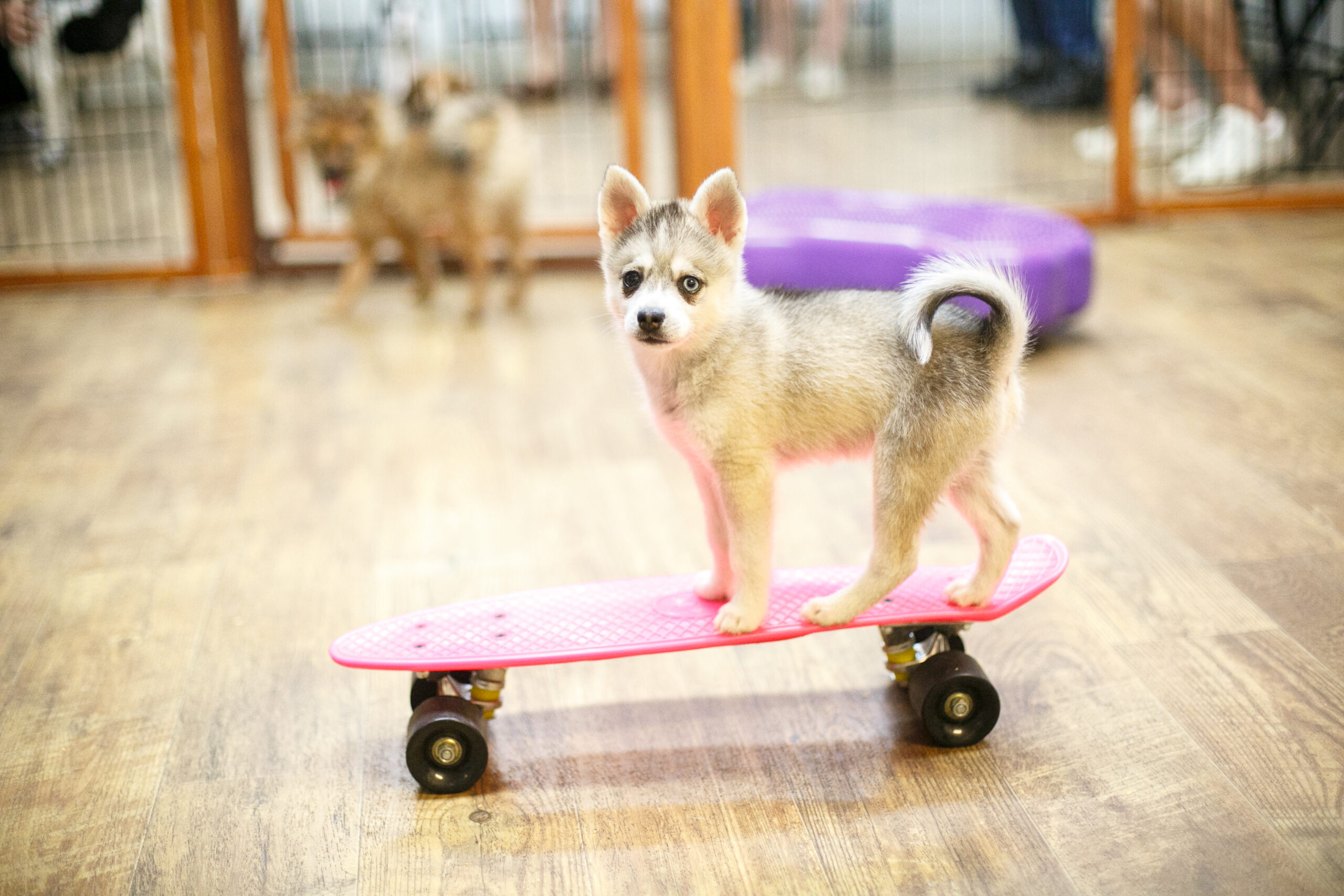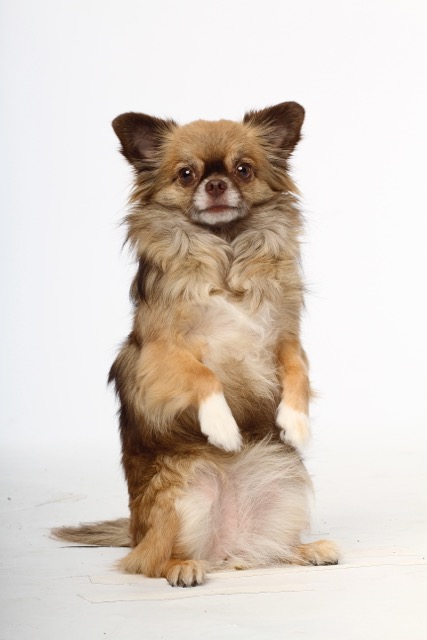
How To Teach a Dog to Stay
Teaching a puppy or a dog to stay put on cue is one of the most basic and useful behaviors to train a dog, but that doesn’t mean it’s the easiest. For a dog to fully comprehend and be able to perform the stay behavior, they first need some foundation skills. It’s helpful if the dog’s person/trainer has a clear idea of what they want their dog to do and what that will look like in a variety of circumstances so they can break the behavior down into its many components. In other words, you will want to break this somewhat difficult behavior into small achievable steps so that your dog will have the skills required to stay for varying periods of time, in various environments, and around a variety of distractions. Trainers often refer to this as the 3 D’s of stay. The three basic components of a dog being able to achieve a strong stay behavior are:
Duration – How long your dog will remain in a cued position such as sit or down.
Distance – How far away you are from the dog whilst they stay.
Distraction – How much activity or commotion your dog can handle without it affecting their ability to respond to the stay cue.
Before we even jump into the training exercises to master the 3 D’s, you will want to be sure your dog’s foundation behaviors are in good shape.
What You Need to Teach Your Dog Prior to Stay
- Your dog should be quick to respond to a visual cue for sit and/or down, and be able to wait a few seconds to be given a treat while remaining in the cued position.
- Your dog should have been practicing and accomplishing basic impulse control around things they desire such as food, water, people, toys, other pets, getting let out of their kennel, going out a door for a walk, etc.
- If your dog has some impulse control around the things they like, they will commonly demonstrate that skill by offering a default manners sit, instead of jumping, grabbing, barking, rushing through doors, etc.
- If your dog has the aforementioned skills, they’re ready to be taught how to stay in the position they were cued to be in until they are cued to do otherwise. You’ll want to start the training in a low distraction environment and you should have high value treats that can be delivered in small, neat pieces so that you can reinforce your dog’s behavior intermittently but generously, without having scraps fall to the floor.
- Having your dog on a lightweight 6 foot leash, and keeping your treats in a hands free treat pouch is advisable.
- Your positive attitude and patience are also important.
Steps to Teach Your Dog to Stay
A dog can be taught a sit stay and a down stay. The different positions can be more or less useful in various scenarios, so teaching both is of great value. A stand stay is also trainable, but is generally considered a more advanced behavior. For the sake of this instructional, we will focus on the stay in a seated position.
Assuming the dog pupil knows how to sit on cue, we will need to teach them a release word that gives them the permission to get up. When your puppy learns the concept of a release word they can begin to wait for your direction and guidance. Choose a word that you will say to let your dog know they can get up. Common release works are “Okay”, “Free”, and “Break”. For the purpose of this instructional, we will use “Okay”.
Note: Another way we could communicate to our dog that they can get out of the sit position would be to give them another cue such as “down” or “come”.
To get started ask your dog to sit. Rather than marking by saying “yes”, “good”, or clicking right away, feed a tiny treat in the seated position every few seconds, so you are reinforcing your puppy for remaining in the seated position. You will need to deliver the treats frequently at first. Then say your marker word “yes” “good” or a clicker and give another tiny treat and then say “Okay” and encourage your dog to move out of the seated position. To start, you can do this by tossing a treat a little bit away on the ground after saying the release word.
Teaching Duration
To work on building the duration of your dog’s stay, you’ll remain right next your dog. Have a goal in mind such as building up to a 20 second stay. When your dog responds to the sit cue, delay how many seconds you wait before marking, rewarding, and releasing your dog. Your goal is to build duration but be sure to vary how long your dog has to wait. You don’t want them to get discouraged by each repetition only getting longer and more difficult. Keep it manageable, fun, and keep them interested and guessing. For instance, a short practice session with numerous repetitions may have wait times that build to 20 seconds interspersed with some shorter times: 2 seconds, 5 seconds, 8 seconds, 3 seconds, 12 seconds, 15 seconds, 6 seconds, 20 seconds, 2 seconds, and so on.
Distance
Once your dog is solid at remaining seated for 20 seconds and is responding quickly to the release word, move on to adding in your body movement as well as distance. It will be hard for your puppy to not want to remain close to you. When you take a step away, your puppy will want to join you. We must break the initiation of this next challenge into small achievable steps. Be patient, knowing that once your puppy gets the idea of staying put while you move around, the learning will begin to go quickly.
Don’t try to help your dog by saying stay or holding your hand out like a stop sign. At this stage, those prompts will only serve to distract and confuse your pup. It’s OK if they occasionally get up. When that happens, just re-cue the sit (or wait a brief moment to see if they reseat themselves on their own). Your dog will learn through a bit of trial and error that when they get up before hearing the release word or being cued to do another behavior that they do not get rewarded. In the future, the reward may still be a treat, or it may be access to a toy, a person, a walk, etc.
With your dog in the seated position, begin to introduce movements. Make the movements small and manageable at first, then slowly build up the challenge. If your puppy is breaking, you are making it too hard. Here is an example of a slow, systematic approach:
- Rock your body side to side – your feet stay planted.
- Rock your body back and fourth so that your torso moves further away but your feet stay close to your dog.
- Make small steps side to side.
- Take one step back away from your dog but keep one foot close by.
- Begin to take a 1/2 step, then a full step back away from your dog.
- Note – at this stage always return to your dog to mark and reward so your dog can learn to settle in a spot away from you, anticipating your returning rather than them bolting up to join you. Later we can incorporate the release word and the dog coming to you to get their reward.
- As your dog gets more confident remaining seated while you take a few steps away, you can increase the amount of steps you take.
- Keep in mind that you are still facing your dog. Also notice that longer duration is naturally occurring with the time it takes to move away.
Have a distance goal in mind, such as 15 feet, and slowly work up to that distance. Just like the beginning duration exercises, don’t continuously move further and further away. Allow some repetitions to be less challenging.
Once you have achieved some distance, periodically release your dog to come to you for their reward, but more often, walk back to your dog to reward them.
Distraction
We often think of distractions as being things that come from other people and the environment. Actually, you, the trainer, is often the greatest distraction to your dog. Consider some things we might do that would distract, excite, or worry our dog, causing them to break from a stay. Rehearse these distractions in training set-ups/scenarios:
- Move/swing your arms side to side and up and down.
- Turn your back on your dog (this is really challenging for your dog so don’t include any duration or distance with this at first).
- Move items to and from a table or on the table.
- Pick things up and put them down.
- Talk, to yourself, to someone else, and on the phone.
- Pop out of view (slowly add being out of view for more duration) – This is particularly different for most novice dogs.
Many of these activities will trigger an individual dog to break the stay, while others will be easy. We can learn a lot about our dogs with these basic distraction exercises. As always, break your steps into small enough increments that your dog can be successful. Work up to greater challenges when your dog is ready. Doing several short sessions a day is the best way for your dog to learn.
As you and your dog progress, the elements of the 3 D’s of stay will overlap considerably.
When your dog is a master at stay in a non-distracting environment, begin to practice in real life situations. Stage the more difficult scenarios so you can control the practice sessions allowing your dog to succeed. Typical applications include:
- Waiting at doorways until told it is okay to go ahead of you or follow you through the threshold.
- Waiting in the car as the door opens until leashed and released to jump out.
- Waiting for the release word when their kennel door is opened rather than rushing out.
- Sitting patiently while their food is prepared and presented, until told they can come get it.
- Waiting for their water bowl to be placed on floor before rushing into it.
- Having your dog wait at the door while you return to get the kitchen to get something you forgot.
- Remaining in a sit stay when the front or back door is opened for a delivery or to let a guest in.
Having a dog that will stay seated in the above situations (and many others) allows us to cohabitate with our canine family members with much greater ease. Stay is not only a wonderful manners behavior, it can also be critical to your dogs safety and wellbeing. For example, a dog that runs out the door can frighten someone, get lost, or be seriously injured. Train your puppy or your adult dog all the basic behaviors they will need to know to live safe and happy lives with their human families, including the all important stay. Playing the training game with your dog is always time well spent in regards to the fun you’ll both have when you employ positive training techniques and the long-term benefits for the whole family.
Explore Our Dog Training Courses
Educate your dog with Andrea Arden and her team.
New York | Los Angeles | Connecticut
Share
- Group Classes
- Private Lessons
- Virtual Training
- Puppy Play Groups
- Puppy Training
- Articles & Advice




